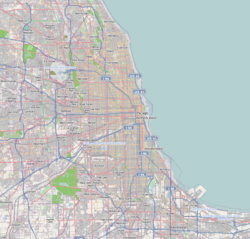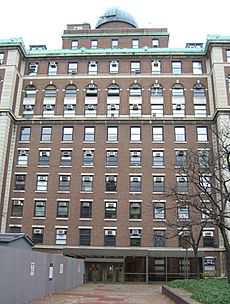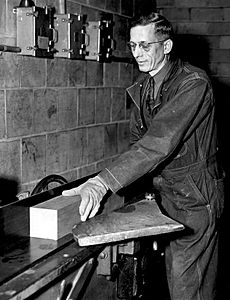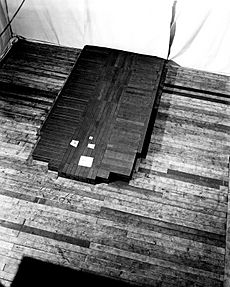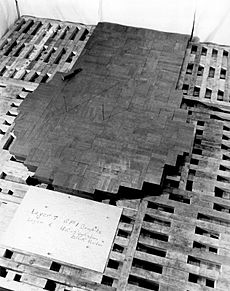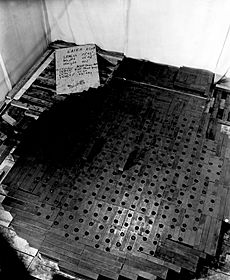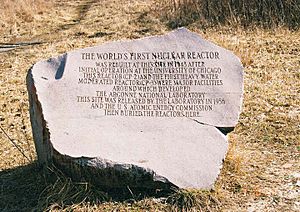Chicago Pile-1 facts for kids
|
Site of the First Self Sustaining Nuclear Reaction
|
|
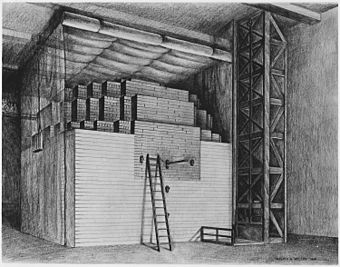 |
|
| Location | Chicago, Illinois, US |
|---|---|
| Built | 1942 |
| NRHP reference No. | 66000314 |
Quick facts for kids Significant dates |
|
| Added to NRHP | 15 October 1966 (66000314) |
| Designated NHL | 18 February 1965 |
| Chicago Pile-1 (CP-1) | |
|---|---|
| Reactor concept | Research reactor |
| Designed and built by | Metallurgical Laboratory |
| Operational | 1942 to 1943 |
| Status | Dismantled |
| Location | Chicago, Illinois |
| Main parameters of the reactor core | |
| Fuel (fissile material) | Natural uranium |
| Fuel state | Solid (pellets) |
| Neutron energy spectrum | Information missing |
| Primary control method | Control rods |
| Primary moderator | Nuclear graphite (bricks) |
| Primary coolant | None |
| Reactor usage | |
| Primary use | Experimental |
| Criticality (date) | 2 December 1942 |
| Operator/owner | University of Chicago / Manhattan Project |
| Remarks | The Chicago Pile-1 (CP-1) was the world's first artificial nuclear reactor |
Chicago Pile-1 (CP-1) was the world's first artificial nuclear reactor. On December 2, 1942, a team led by scientist Enrico Fermi started the first human-made, self-sustaining nuclear chain reaction in CP-1. This secret project was a major step for the Manhattan Project. The Manhattan Project was an effort by the Allied powers to create atomic bombs during World War II.
CP-1 was developed by the Metallurgical Laboratory at the University of Chicago. It was built under the west stands of the university's old Stagg Field. Even though leaders worried about a dangerous runaway reaction, they trusted Fermi's safety plans. They decided to do the experiment in a busy city area. Fermi described the reactor as "a crude pile of black bricks and wooden timbers."
The reactor was put together in November 1942 by a team including Fermi, Leo Szilard, Leona Woods, and others. It used natural uranium and a lot of nuclear graphite as a neutron moderator. The reactor had 45,000 ultra-pure graphite blocks, weighing about 360 short tons (327,000 kg). It was fueled by 5.4 short tons (4,900 kg) of uranium metal and 45 short tons (41,000 kg) of uranium oxide. Unlike most later reactors, CP-1 had no radiation shielding or cooling system. This was because it ran at a very low power, only about half a watt.
The race to build a reactor began because people worried that Nazi Germany was ahead in nuclear science. CP-1's success showed that using nuclear energy for military purposes was possible for the Allies. It also highlighted the real danger that Nazi Germany might build nuclear weapons. Before this, scientists could only guess how much material was needed for a bomb. Using graphite as a moderator was a big breakthrough for the Allies. Germany's program struggled partly because they thought they needed expensive heavy water for their reactors.
In 1943, CP-1 was moved to Red Gate Woods and rebuilt as Chicago Pile-2 (CP-2). It was used for research until 1954, when it was taken apart and buried. The stands at Stagg Field were torn down in 1957. Today, the site is a National Historic Landmark and a Chicago Landmark.
Contents
How the Idea Started
The idea of a chain reaction first came from German chemist Max Bodenstein in 1913. He thought about how some chemicals could react and then cause more chemicals to react. The idea of a nuclear chain reaction was first thought of by Hungarian scientist Leo Szilard in 1933. Szilard realized that if a nuclear reaction released neutrons, these neutrons could cause more reactions. This process could keep itself going. He even thought about using uranium as a fuel. He filed a patent for his nuclear reactor idea the next year.
In 1938, German chemists Otto Hahn and Fritz Strassmann discovered nuclear fission. This meant that a uranium atom could split. Their colleagues Lise Meitner and Otto Frisch explained this discovery. This opened up the chance to create a nuclear chain reaction with uranium. However, early experiments were not successful.
For a chain reaction to happen, splitting uranium atoms had to release more neutrons to keep the reaction going. At Columbia University in New York, Italian physicist Enrico Fermi and his team did the first nuclear fission experiment in the United States in 1939. Later work confirmed that fast neutrons were indeed produced when atoms split. Szilard and Walter Zinn then showed that natural uranium could multiply neutrons. This proved that a chain reaction might be possible.
Fermi and Szilard still thought that huge amounts of uranium would be needed for an atomic bomb. So, they focused on creating a controlled chain reaction. Fermi found that slowing down neutrons with a neutron moderator made them more likely to be captured by uranium. This would cause the uranium to split. Szilard suggested using carbon in the form of graphite as a moderator. They also considered expensive heavy water as a backup. Fermi estimated that each splitting uranium atom produced about 1.73 neutrons. This was enough, but careful design was needed to avoid losing too many neutrons.
Scientists like Herbert G. MacPherson and Victor C. Hamister at National Carbon Company helped. They found ways to make very pure graphite. This was important because impurities like boron could absorb neutrons and stop the reaction. Their pure graphite, called AGOT graphite, became the first true nuclear-grade graphite. By November 1942, National Carbon had sent 255 short tons (231,000 kg) of this graphite to the University of Chicago for CP-1.
Getting Government Help
Szilard wrote a secret letter to President Franklin D. Roosevelt. He warned about a German nuclear weapon project and explained how nuclear weapons could be made. He asked for a program to develop them. With help from Eugene Wigner and Edward Teller, Szilard convinced Albert Einstein to sign the letter in 1939. Einstein's fame helped the proposal.
This letter led the U.S. government to start researching nuclear fission. An Advisory Committee on Uranium was formed. Its first meeting in October 1939 led to the Army and Navy giving $6,000 for Szilard to buy supplies, especially more graphite.
In April 1941, the National Defense Research Committee (NDRC) created a special project. It was led by Arthur Compton, a Nobel-Prize-winning physics professor at the University of Chicago. Compton's report in May 1941 discussed the possibility of radiological weapons, nuclear propulsion for ships, and nuclear weapons using uranium-235 or the new element plutonium. In October, he wrote another report on how practical an atomic bomb would be. For this, he worked with Fermi on calculating the critical mass of uranium-235.
Scientists had theorized that heavy elements with odd atomic numbers could be split. This meant plutonium-239 was likely to be fissile. In May 1941, Emilio Segrè and Glenn Seaborg made a tiny amount of plutonium-239. They found it absorbed neutrons even better than uranium-235. Compton was put in charge of the plutonium project in December. Its goals were to make reactors to turn uranium into plutonium, separate plutonium from uranium, and design an atomic bomb. Compton had to choose which reactor designs to pursue, even though no successful reactor had been built yet. He aimed for a controlled nuclear chain reaction by January 1943 and an atomic bomb by January 1945.
Building the Reactor
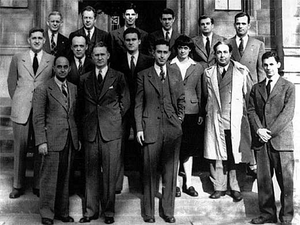
In a nuclear reactor, "criticality" means that the rate of neutron production equals the rate of neutron loss. When a uranium-235 atom splits, it releases about 2.4 neutrons. For a self-sustaining nuclear chain reaction to happen, the neutron multiplication factor (called k) must be slightly greater than 1. This means each reaction must cause more than one new reaction. But it must not go too high, or the reaction would quickly get out of control.
Fermi called his device a "pile." He simply meant a "heap" of materials.
Fermi began planning to build a smaller test pile in August 1941. This "exponential pile" was 8 feet (2.4 m) long, 8 feet (2.4 m) wide, and 11 feet (3.4 m) high. It was too big for the usual labs. A large room was found in Schermerhorn Hall.
The pile was built in September 1941 using graphite blocks and tin cans filled with uranium oxide. The cans were 8-inch (20 cm) cubes, each weighing about 60 pounds (27 kg) when filled. Football players from Columbia University helped move the heavy cans. The result was a disappointing k of 0.87, meaning it couldn't sustain a reaction.
Compton felt that having teams in different universities was causing too much overlap. He decided to bring all the work to one place: the University of Chicago. Chicago was central, and scientists were easier to find there. Before moving, Fermi's team tried one last pile at Columbia. They removed the cans, which had absorbed neutrons. Instead, uranium oxide was pressed into holes drilled in the graphite. This improved the k factor to 0.918, still not enough.
Choosing the Location
In Chicago, Samuel K. Allison found a good spot under the stands at Stagg Field. It was a former rackets court, about 60 feet (18 m) long, 30 feet (9.1 m) wide, and 26 feet (7.9 m) high. The area was unheated and very cold in winter. Allison built a 7-foot (2.1 m) experimental pile there before Fermi's group arrived in 1942.
The United States Army Corps of Engineers took over the nuclear weapons program in June 1942. Compton's Metallurgical Laboratory became part of the Manhattan Project. General Leslie R. Groves, Jr. became the project director. Between September and November 1942, teams built 16 experimental piles under the Stagg Field stands.
Fermi designed a new, spherical pile to get the best k factor, which was expected to be around 1.04. Leona Woods built boron trifluoride neutron detectors. She also helped find the large number of 4-by-6-inch (10 by 15 cm) timbers needed. High-purity graphite arrived from National Carbon, and pure uranium dioxide from Mallinckrodt. Metallic uranium also started arriving in larger amounts.
The Army had chosen a site in the Red Gate Woods near Chicago for a plutonium plant. This was called "Site A." A building there was started for Fermi's experimental pile, but construction was delayed. By early November, Fermi suggested building the pile under the stands at Stagg Field instead.
Building an active reactor in a populated area was a big risk. There was a danger of a terrible nuclear meltdown that could spread radioactive material. However, the physics suggested the pile could be safely shut down. When a fuel atom splits, it releases neutrons that hit other atoms, causing a chain reaction. This happens very fast. But some neutrons are released later, from the fission products. These "delayed neutrons" account for about three percent of the total.
Fermi argued that by using these delayed neutrons, the reaction could be controlled. If operators saw a sudden increase in neutrons, they would have several minutes to act before a runaway reaction. If a neutron absorber, like a control rod, was put in, the reactor would shut down. Compton agreed that this delay provided enough safety. He allowed Fermi to build Chicago Pile-1 at Stagg Field.
Compton later explained that he didn't ask his superior, President Hutchins, because Hutchins would have had to say no for the university's safety. Compton felt that saying no would have been wrong given the urgency. General Groves also had "serious misgivings" but did not stop the project.
Building CP-1
Chicago Pile-1 was built inside a large balloon. This was so the air inside could be replaced with carbon dioxide. The Goodyear Tire and Rubber Company made the 25-foot (7.6 m) cube-shaped balloon. Building began on November 16, 1942. The first layer was only graphite blocks. Layers without uranium were alternated with two layers containing uranium. This way, the uranium was surrounded by graphite. The reactor had no radiation shielding or cooling system because it was meant to run at very low power.
The work happened in twelve-hour shifts. Walter Zinn led the day shift, and Herbert L. Anderson led the night shift. They hired thirty high school dropouts to help. These workers machined 45,000 graphite blocks and 19,000 pieces of uranium metal and uranium oxide. Graphite dust filled the air, making the floor slippery.
Another team, led by Volney C. Wilson, made the instruments. They also built the control rods. These were cadmium sheets nailed to wooden strips. Cadmium is very good at absorbing neutrons. They also made the "scram line," a manila rope. If cut, this rope would drop a control rod into the pile, stopping the reaction.
About two layers were laid per shift. Leona Woods' neutron counter was put in at the 15th layer. After that, readings were taken at the end of each shift. Fermi used these readings to track how close the pile was to criticality. The original plan was for a spherical pile. But as they worked, they realized it wasn't needed. The new graphite was purer, and 6 short tons (5,400 kg) of very pure metallic uranium arrived from the Ames Project.
These 2.25-inch (5.7 cm) metallic uranium cylinders, called "Spedding's eggs," were used instead of uranium oxide. This meant they wouldn't need to fill the balloon with carbon dioxide. Fermi's new calculations showed the pile would reach criticality between the 56th and 57th layers. So, the final pile was flatter on top. Anderson stopped work after the 57th layer. The finished pile was an elliptical shape, 20 feet (6.1 m) high, 6 feet (1.8 m) wide at the ends, and 25 feet (7.6 m) across the middle. It contained 6 short tons (5,400 kg) of uranium metal, 50 short tons (45,000 kg) of uranium oxide, and 400 short tons (360,000 kg) of graphite. The estimated cost was $2.7 million.
The First Nuclear Chain Reaction
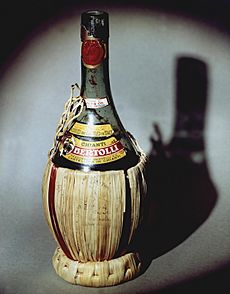
On December 2, 1942, 49 scientists gathered for the experiment. Fermi, Compton, Anderson, and Zinn were on the balcony, where the controls were. Samuel Allison stood ready with a bucket of concentrated cadmium nitrate. He was to throw it over the pile if there was an emergency.
The startup began at 9:54 AM. Walter Zinn removed the "zip," an emergency control rod, and secured it. Norman Hilberry stood with an axe, ready to cut the scram line. This would let the zip rod fall and stop the reaction. Leona Woods loudly called out readings from the neutron detector. George Weil, the only one on the floor, pulled out all but one of the control rods. At 10:37 AM, Fermi told Weil to remove all but 13 feet (4.0 m) of the last control rod. Weil pulled it out 6 inches (15 cm) at a time, with measurements taken at each step.
The process stopped suddenly when the automatic control rod put itself back in. Its safety level was set too low. At 11:25 AM, Fermi ordered the control rods put back in. Then he announced it was lunch time.
The experiment started again at 2:00 PM. Weil worked the final control rod while Fermi watched the neutron activity carefully. Fermi announced that the pile had gone critical (reached a self-sustaining reaction) at 3:25 PM. Fermi changed the recorder's scale to handle the quickly rising electrical current from the detector. He wanted to test the control circuits. After 28 minutes, alarm bells rang, showing the neutron level had passed the safety limit. Fermi told Zinn to release the zip. The reaction quickly stopped. The pile had run for about 4.5 minutes at about 0.5 watts. Wigner opened a bottle of Chianti wine, and they drank from paper cups to celebrate.
Compton called James B. Conant to tell him the news. They used a simple code:
Compton: The Italian navigator has landed in the New World.
Conant: How were the natives?
Compton: Very friendly.
What Happened Next
On December 12, 1942, CP-1's power was increased to 200 watts, enough to power a light bulb. Since it had no shielding, it was a radiation risk. Further testing was done at 0.5 watts. CP-1 was shut down on February 28, 1943. It was taken apart and moved to "Site A" in the Argonne Forest, now called Red Gate Woods. There, the original materials were used to build Chicago Pile-2 (CP-2).
CP-2 was cube-shaped, about 25 feet (7.6 m) tall with a 30-foot (9.1 m) square base. It was surrounded by 5-foot (1.5 m) thick concrete walls for radiation shielding. It had 6 inches (15 cm) of lead and 50 inches (130 cm) of wood on top. More uranium was used, so it had 52 short tons (47,000 kg) of uranium and 472 short tons (428,000 kg) of graphite. It had no cooling system because it only ran at a few kilowatts. CP-2 started working in March 1943.
CP-2 was joined by Chicago Pile-3, the first heavy water reactor, which started on May 15, 1944. These reactors were used for research related to weapons. They measured how elements absorbed neutrons. Scientists like Albert Wattenberg studied about 10 elements each month. As the dangers of things like inhaling uranium oxide became clear, experiments were done on how radioactive substances affected lab animals.
Szilard and Fermi jointly patented the design, calling it the "neutronic reactor." The patent was filed in 1944.
The Red Gate Woods later became the first site of Argonne National Laboratory. Zinn became its first director in 1946. CP-2 and CP-3 worked for ten years. Zinn ordered them shut down on May 15, 1954. Their usable fuel was moved to Chicago Pile-5. CP-2 and CP-3 were taken apart in 1955 and 1956. Some graphite blocks from CP-1/CP-2 were reused in another reactor. High-level nuclear waste was sent to Oak Ridge, Tennessee, for disposal. The rest was put in concrete and buried in a 40-foot (12 m) deep trench. This spot is now called the Site A/Plot M Disposal Site and is marked by a boulder.
By the 1970s, people worried about radioactivity at the site, which was used for recreation. Surveys in the 1980s found some radioactive materials in the soil and nearby wells. In 1994, the United States Department of Energy and Argonne National Laboratory agreed to clean up the site. About 500 cubic yards (380 m³) of radioactive waste were removed and sent to the Hanford Site. By 2002, health officials said the remaining materials were not a danger to public health.
Why CP-1 Was Important
The successful test of CP-1 proved that a nuclear reactor could work. It also showed that the k factor was larger than expected. This meant that cheaper coolants like air or water could be used instead of expensive helium. It also gave more choices for materials for pipes and control systems. Wigner then pushed forward with his design for a water-cooled reactor.
There were still concerns about whether a graphite reactor could make plutonium on a large scale. So, the Manhattan Project kept developing heavy water production. An air-cooled reactor, the X-10 Graphite Reactor, was built in Oak Ridge. Then, larger water-cooled reactors were built at the Hanford Site in Washington state. Enough plutonium was made for an atomic bomb by July 1945, and for two more in August.
A plaque was put up at Stagg Field on December 2, 1952, ten years after CP-1 went critical. It said:
On December 2, 1942 man achieved here the first self-sustaining chain reaction and thereby initiated the controlled release of nuclear energy.
The plaque was saved when the West Stands were torn down in 1957. The CP-1 site was named a National Historic Landmark in 1965 and a Chicago Landmark in 1971.

Today, the site of old Stagg Field is where the University's Regenstein Library and Joe and Rika Mansueto Library stand. A sculpture by Henry Moore, Nuclear Energy, is in a small area outside the Regenstein Library. It was put there on December 2, 1967, to remember the 25th anniversary of CP-1. The plaques from 1952, 1965, and 1967 are also nearby. A graphite block from CP-1 can be seen at the Bradbury Science Museum in Los Alamos, New Mexico. Another is at the Museum of Science and Industry in Chicago. On December 2, 2017, the 75th anniversary, the Massachusetts Institute of Technology finished restoring a research graphite pile, similar to CP-1.
Images for kids
See also
 In Spanish: Chicago Pile-1 para niños
In Spanish: Chicago Pile-1 para niños


